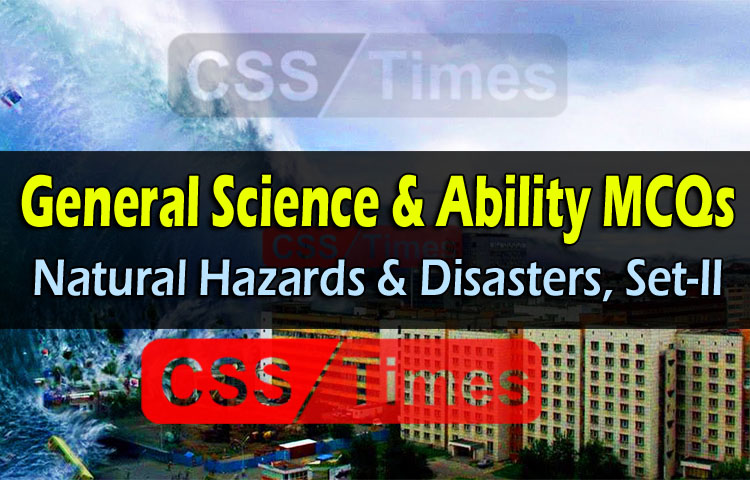Read General Science & Ability MCQs (Natural Hazards and Disasters, Set-I)
An example of a shield volcano is
(a) Mount Fuji
(b) Mount Pinatubo
(c) Puy de Dome
(d) Mauna Loa
Answer: (d)
Mauna Loa is one of five volcanoes that form the Island of Hawaii in the U.S. state of Hawaii in the Pacific Ocean.Mauna Loa is a shield volcano that has erupted some three dozen times since its first well-documented eruption in 1843
Volcanoes that have erupted in historic times and are still likely to erupt, are known as
(a) Active volcanoes
(b) Dormant volcanoes
(c) Extinct volcanoes
(d) Instinct volcanoes
Answer: (b)
Top of magma is forced onto Earth’s surface is known as
(a) Vent
(b) Cone
(c) Pipe
(d) Crater
Answer: (d)
A volcanic crater is a roughly circular depression in the ground caused by volcanic activity. It is typically a bowl-shaped feature within which occurs a vent or vents
Volcano that forms from column of magma is called a/an
(a) underwater volcano
(b) convergent volcano
(c) divergent volcano
(d) hot spot volcano
Answer: (d)
Reference to how thick a liquid is known as
(a) density
(b) conductivity
(c) viscosity
(d) volatility
Answer: (c)
Fluidity of lava is determined by amount of
(a) copper
(b) iron
(c) nickel
(d) silica
Answer: (d)
Read Also: Constituents and Structure Solved MCQs (Set-I) | General Science & Ability
A flash flood is a flood that:
(a) is caused by heavy rain rather than from the flooding of a river
(b) occurs in urban areas
(c) occurs suddenly and unexpectedly and for a short duration
(d) is caused by the blocking of drains.
Answer: (c)
Flash floods are defined by the speed of flooding, not the source or location of flooding. While flash floods are often caused by heavy rainfall, they can also result from other events, such as drain blockages and bursts or the flooding of a river.
Monsoon is caused by: (CSS-2009)
(a) Seasonal reversal of winds
(b) Revolution of earth
(c) Movement of clouds
(d) Rise in temperature
(e) Rain forests
Answer: (a)
The monsoon, which is essentially the seasonal reversal in wind direction, causes most of the rainfall received in Pakistan and some other parts of the world. The primary cause of monsoons is the difference between annual temperature trends over land and sea. The apparent position of the Sun with reference to the Earth oscillates from the Tropic of Cancer to the Tropic of Capricorn. Thus the low pressure region created by solar heating also changes latitude. The northeast and southeast trade winds converge in this low pressure zone, which is also known as the Intertropical Convergence Zone or ITCZ. This low pressure regions sees continuous rise of moist wind from the sea surface to the upper layers of the atmosphere, where the cooling means the air can no longer hold so much moisture resulting in precipitation. The rainy seasons of East Asia, sub-Saharan Africa, Australia and the southern parts of North America coincide with the shift of ITCZ towards these regions.
A flood can vary in:
(a) size
(b) speed of water flow
(c) duration
(d) all of the above.
Answer: (d)
The size, duration and water flow speed of floods can vary. The volume, rate of rise and areal extent (i.e. the total area under flood waters) of flooding can also vary.
When a river’s water level reaches 10 meters, this means that:
(a) the water level is 10 meters above an arbitrary ‘zero’ level
(b) the water level is 10 meters above mean sea level
(c) the water level is 10 meters above mean sea level or an arbitrary ‘zero’ level
(d) it will flood.
Answer: (c)
River height is the level of water in a river as measured by a river gauging station and is expressed in meters above either the Australian Height Datum (i.e. mean sea level) or an alternative arbitrary ‘zero’ level, depending on the location.
Read Also: General Science and Ability MCQs Solved (Exercise-1)
The size of a flood is measured by:
(a) the rate of flow of water in a waterway or river
(b) the level of water in a waterway or river
(c) a river gauging station
(d) all of the above.
Answer: (d)
The size of a flood can be measured by the highest level that water in a waterway reaches, referred to as the ‘peak water level’ or ‘flood peak’. It can also be measured by the maximum water flow rate in a waterway, referred to as the ‘peak flow rate’ or ‘peak water flow’. Each of these variables can be measured using a river gauging station.
Which of the following is associated with a La Niña event?
(a) The Southern Oscillation Index (SOI) is strongly negative.
(b) The ocean surface off the coast of South America is warmer than usual.
(c) There is an increased chance of above average rainfall in eastern Australia.
(d) All of the above.
Answer: (c)
In a La Niña event, the equatorial ocean surface off the coast of South America is abnormally cool, and the SOI is strongly positive. Trade winds blow strongly across the warm Pacific, picking up plenty of moisture and increasing the likelihood of above average rainfall in eastern Australia.
Which of the following potentially affects the size of a flood?
(a) bridges and other structures in waterways
(b) the size and windiness of a river
(c) vegetation in and around a river
(d) all of the above.
Answer: (d)
Many factors can affect the size of a flood, including rainfall intensity, weather conditions prior to a rainfall event, tidal and storm surges, dams and other man-made and natural water storages, catchment size and shape, soil types in a catchment, vegetation in and around a waterway, the size and windiness of a waterway, levees, bridges and other structures in waterways and catchments, and urbanization.
Seasons are generated by (CSS-2012)
(a) The movement of sun around the Milky Way
(b) The movement of the earth around the sun
(c) Relativistic Quantum
(d) None of these
Answer: (b)
The 2010 floods had cost the Pakistan’s economy around
(a) $17b
(b) $11b
(c) $10b
(d) $13b
Answer: (c)
It estimates that just a little less than 1pc of Pakistan’s GDP is exposed to river floods every year. It is ranked 16th by the WRI on the list of the top 20 countries with the highest GDP exposure to river floods.
The World Resources Institute (WRI) says Pakistan falls 5th on the list of top 15 countries that account for 80pc of the population exposed to river-flood risk worldwide.
In Pakistan, the most expensive natural disaster is:
(a) Drought
(b) Floods
(c) Bushfires
(d) Cyclones.
Answer: (b)
Pakistan faces a major financing challenge arising from natural catastrophes, with flooding causing an estimated annual economic impact of between three and four per cent of the federal budget,” adds the report. It estimates the annual economic impact of flooding at between $1.2bn and $1.8bn, or 0.5-0.8pc of GDP.
Which of the following is an environmental consequence of floods?
(a) dispersal of weed species
(b) erosion of soil
(c) release of pollutants into waterways
(d) all of the above.
Answer: (d)
Floods can have negative environmental consequences, such as soil erosion, release of pollutants and excess sediments and nutrients into waterways and the ocean, dispersal of weed species, and negative impacts on fish and other aquatic life. Floods can also have positive environmental consequences, such as recharging groundwater systems, filling wetlands, moving useful nutrients around the landscape, and triggering breeding events (for example, of water birds).
Which of the following is used to estimate which areas will be inundated during a flood, based on river height information?
(a) satellite and radar images
(b) flood maps / floodplain hydraulic models
(c) river gauging stations
(d) all of the above.
Answer: (b)
Floodplain hydraulic models and flood maps are used to estimate which areas will be inundated based on river height information. Satellite and radar images, rain gauges and river gauging stations are used to estimate river heights.
Which of the following statements is false?
(a) Weather forecasts for a small region are more accurate than those for a large region.
(b) Weather forecasts are more accurate in Melbourne than in Darwin.
(c) Forecasts of temperature are more accurate than forecasts of rainfall.
(d) All of the above.
Answer: (a)
The accuracy of weather forecasts varies depending on lead time, the size of the region of interest, the weather variable being forecast, and the latitude of the region. Generally, temperature forecasts are more accurate than rainfall forecasts; the mid-latitudes are easier to forecast than the tropics; and it is generally easier to forecast rainfall over a large area (for example, a large catchment) than local rainfall (for example, a reservoir).
Read Also: General Science (Everyday Science) Important Solved MCQs for Competitive Exams (Set II)
Which of the following is true? Flood warnings:
(a) should not be released until the information is certain
(b) should indicate what the threat is, what
(c) action should be taken, by whom and when
(d) are best if they come from a single source
(e) all of the above.
Answer: (b)
Flood warnings should provide information on what the threat is, what action should be taken, by whom and when. While it is desirable for flood warnings to be accurate, warnings are predictions about the future, so there is inevitably some uncertainty. Accuracy needs to be balanced with timeliness, to allow enough time for appropriate action. Warnings are most likely to reach different audiences and to be heeded if they come from multiple trusted sources.
Flood risk refers to:
(a) the chance of a flood occurring
(b) the number of people and properties exposed to floodwaters if a flood occurs
(c) the vulnerability of people and properties that are exposed to floodwaters
(d) all of the above.
Answer: (d)
Flood risk includes both the chance (or probability) of a flood occurring, and the consequences if a flood occurs. The consequences of a flood are in turn affected by the number of people and properties exposed to floodwaters for a flood of a particular size, and the vulnerability of those people and properties. For example, a river might burst its banks regularly, but if this flooding occurs in an isolated area where there are no people or infrastructure, then the risk is low. Similarly, a river might flood very rarely, but if many people and properties are located near this river and they live in dwellings that are vulnerable to water damage, then the flood risk will be greater.
Which of the following can reduce the risk of flooding?
(a) zonings and building regulations for new developments
(b) dams, detention basins and levees
(c) flood awareness and education programs
(d) all of the above.
Answer: (d)
Flood risk in new developments can be reduced by restricting the location of development (zonings) and placing controls (regulations) on development. In existing developed areas, risk can be reduced by modifying flood behaviour (for example, through dams, detention basins, levees, waterway modifications), property modification measures (for example, land filling, flood proofing, house raising, removing developments), and response modification measures (for example, upgrading flood evacuation routes, flood warnings, flood evacuation planning, flood education programs).
The Probable Maximum Flood is:
(a) an estimation of the largest possible flood that could occur at a particular location
(b) the maximum flood experienced in the last 100 years
(c) the maximum flood experienced in the last 200 years
(d) the maximum flood experienced since flood records have existed.
Answer: (d)
The Probable Maximum Flood (PMF) is an estimate of the largest possible flood that could occur at a particular location, under the most severe meteorological and hydrological conditions as they are currently understood.
In the future, which of the following is expected to increase the risk of flooding?
(a) population growth
(b) urbanization
(c) climate change
(d) all of the above.
Answer: (d)
In the future, climate change is likely to result in an increased chance of flash floods and coastal inundation. Australia’s growing population and urbanization are likely to place increased pressure on our waterways and to increase the chance of flooding in cities and the number of properties and people exposed to floodwaters.
In the future, which of the following is unlikely?
(a) There will be an increased chance of flash flooding and coastal inundation.
(b) Flood risk will increase due to population growth and urbanization.
(c) Improvements in flood forecasting and warning technologies will reduce the impacts of floods.
(d) We will be able to eliminate the risk of flooding.
Answer: (d)
It is not possible to eliminate the risk of flooding. Indeed, it is likely that flood risk will increase in the future due to climate change, population growth and urbanization. However, we can better manage flood risk through improvements in flood forecasting and warning technologies, as well as improved land use planning, floodplain management and integrated water management.
Higher level of floods and droughts are led by
(a) sand storms
(b) lower precipitation
(c) higher precipitation
(d) none of the above
Answer: (c)
Approximately how fast do tsunami waves travel in the open ocean?
(a) 100 km/hour
(b) 1600 km/hour
(c) 200 km/hour
(d) 400 km/hour
(e) 800 km/hour
Answer: (e)
Tsunami waves travel between 500 and 950 km/hour.
What can cause a tsunami?
(a) Landslide
(b) Underwater earthquake
(c) Volcanic eruption
(d) All of the above
Tsunamis are usually generated by undersea earthquakes at tectonic plate boundaries, but they can also be triggered by underwater landslides, volcanic eruptions, or even a giant meteor impact with the ocean.
Do all undersea earthquakes trigger a tsunami?
(a) Yes
(b) No
Answer: (b)
An undersea earthquake creates a tsunami only if it is of sufficient force and there is a violent enough movement of the seafloor to displace a massive amount of water.
What does the word “tsunami” mean in Japanese?
(a) Tidal wave
(b) Harbor wave
(c) Killer wave
(d) Century wave
Answer: (b)
English word “tsunami” comes from the Japanese term for “harbor wave.” Tsunamis are not the same things as tidal waves and actually consist of a series of waves.
Witnesses have said that an approaching tsunami sounds like what?
(a) Firecrackers exploding
(b) A freight train
(c) Ice cracking
(d) Nothing—there is absolute silence
Answer: (b)
Many witnesses have described the sound of an approaching tsunami as being similar to a freight train’s.
What is the most active tsunami area?
(a) Pacific Ocean
(b) Caribbean Sea
(c) Indian Ocean
(d) North Atlantic Ocean
Answer: (a)
Most tsunamis, about 80 percent, happen within the Pacific Ocean’s Ring of Fire, a geologically active area where tectonic shifts make volcanoes and earthquakes common.
What is the deadliest tsunami ever recorded?
(a) The 1782 South China Sea tsunami
(b) The 1868 northern Chile tsunami
(c) The 1883 South Java Sea tsunami
(d) The 2004 Indian Ocean tsunami
Answer: (d)
In 2004 more than 200,000 people—the most ever recorded—died in an Indian Ocean tsunami that was triggered by an earthquake off Sumatra, Indonesia.
How fast can a tsunami travel?
(a) Up to 100 miles an hour (160 kilometers an hour)
(b) Up to 200 miles an hour (320 kilometers an hour)
(c) Up to 500 miles an hour (800 kilometers an hour
(d.) Up to 1,000 miles an hour (1,600 kilometers an hour)
Answer: (c)
Tsunamis race across the sea at up to 500 miles (805 kilometers) an hour—about as fast as a jet airplane. At that pace they can cross the entire expanse of the Pacific Ocean in less than a day.
Can you detect a tsunami in the open ocean?
(a) Yes
(b) No
Answer: (b)
No. In the open ocean, the wave length of a tsunami is hundreds of miles long and only a few feet high. Boaters are safer out at sea during a tsunami than close to shore or tied up at port.
Where was the largest tsunami in history recorded?
(a) India
(b) Philippines
(c) Chile
(d) Japan
Answer: (d)
In 1971 a wall of water 278 feet (84.7 meters) high surged past Ishigaki Island, Japan. It moved a 750-block of coral 1.5 miles (2.4 kilometers) closer to shore but did little other damage.
What is frequently a warning sign of an impending tsunami?
(a) Winds suddenly change direction
(b) The sky suddenly clears
(c) Seawater suddenly retreats from the shore
(d) All of the above
Answer: (c)
If the tsunami’s trough reaches shore first, it sucks the water seaward, exposing the seafloor suddenly. The wave’s crest usually hits shore about five minutes later. Recognizing this phenomenon—and getting to higher ground immediately—can save lives.
Which one of the following is an example of non-renewable resources?
(a) Wind
(b) Water
(c) Vegetation
(d) Coal and minerals
Answer: (d)
Which of the following is a renewable resource?
(a) Soil
(b) Water
(c) Flora and fauna
(d) All the above
Answer: (d)
_____ of stratosphere provides protection to our life.
(a) Nitrogen
(b) Hydrogen
(c) Ozone
(d) Argon
Answer: 3
The life supporting gases such as O2, CO2 and N2 are chiefly concentrated in the_______.
(a) Troposphere
(b) Exosphere
(c) Homosphere
(d) Stratosphere
Answer: (a)
Which of the following soil is the best for plant growth?
(a) Sandy soil
(b) Clay
(c) Gravel
(d) Loamy soil
Answer: (d)
Both power and manure are provided by _______.
(a) Thermal plants
(b) Nuclear plants
(c) Biogas plants
(d) Hydroelectric plants
Answer: (c)
In the atmosphere, the layer above the troposphere is _____.
(a) Stratosphere
(b) Exosphere
(c) Mesosphere
(d) Thermosphere
Answer: (a)
______ is the major raw material for biogas.
(a) Plant leaves
(b) Cow dung
(c) Mud
(d) Grass
Answer: (b)
A biosphere reserve conserves and preserves_______.
(a) Wild animals
(b) Wild land
(c) Natural vegetation
(d) All the above
Answer: (d)
Atomic energy is obtained by using ores of_______.
(a) Copper
(b) Uranium
Answer: (b)
Sanctuaries are established to_______.
(a) Rear animals for milk
(b) Entrap animals
(c) Protect animals
(d) None of the above
Answer: (c)
An animal sanctuary is a facility where animals are brought to live and be protected for the rest of their lives. Unlike animal shelters, sanctuaries do not seek to place animals with individuals or groups, instead maintaining each animal until his or her natural death. At present there are 99 Wildlife Sanctuaries in Pakistan
The death of the last individual of a species is called_______.
(a) Extinction
(b) Clad
(c) Neither (a) nor (b)
(d) Species diversity
Answer: (a)
In biology and ecology, extinction is the end of an organism or of a group of organisms (taxon), normally a species. The moment of extinction is generally considered to be the death of the last individual of the species, although the capacity to breed and recover may have been lost before this point.
Which one of the following is not a fossil fuel?
(a) Natural gas
(b) Petrol
(c) Coal
(d) Uranium
Answer: (d)
Fossil fuels are sources of energy that have developed within the earth over millions of years. Because fossil fuels – oil, natural gas, and coal – take so long to form, they are considered nonrenewable
Biogas generation is mainly based on the principle of_______.
(a) Fermentation
(b) Degradation
(c) Putrification
(d) Both (a) and (b)
Answer: (a)
The biogas plant operating on the principle of a wet anaerobic fermentation process was selected for the determination of the composition of in-put raw material which is determinative for the final biogas quality. The biogas plant is designed as an accumulation through-flow device. The biogas production takes place during the wet fermentation process in the mesophile operation (average temperature 40°C). The produced biogas is used in a cogeneration unit. The biogas plant operates in automatic mode.
Floods can be prevented by_______.
(a) Afforestation
(b) Cutting the forests
(c) Tilling the land
(d) Removing the top soil
Answer: (a)
Afforestation is the establishment of a forest or stand of trees in an area where there was no forest. Reforestation is the reestablishment of forest cover, either naturally (by natural seeding, coppice, or root suckers) or artificially (by direct seeding or planting).
Afforestation Trees are planted near to the river. This means greater interception of rainwater and lower river discharge. This is a relatively low cost option, which enhances the environmental quality of the drainage basin.







